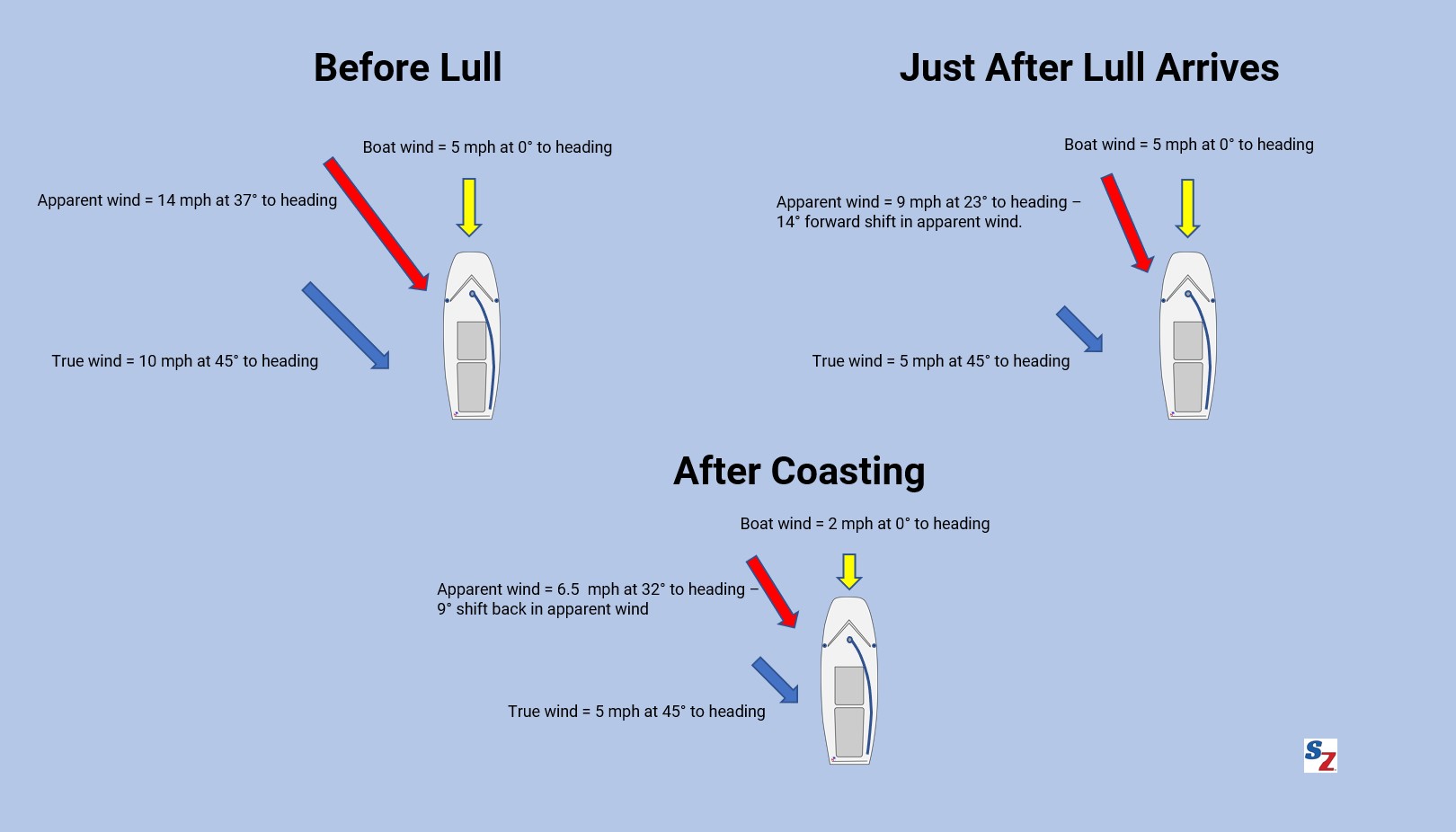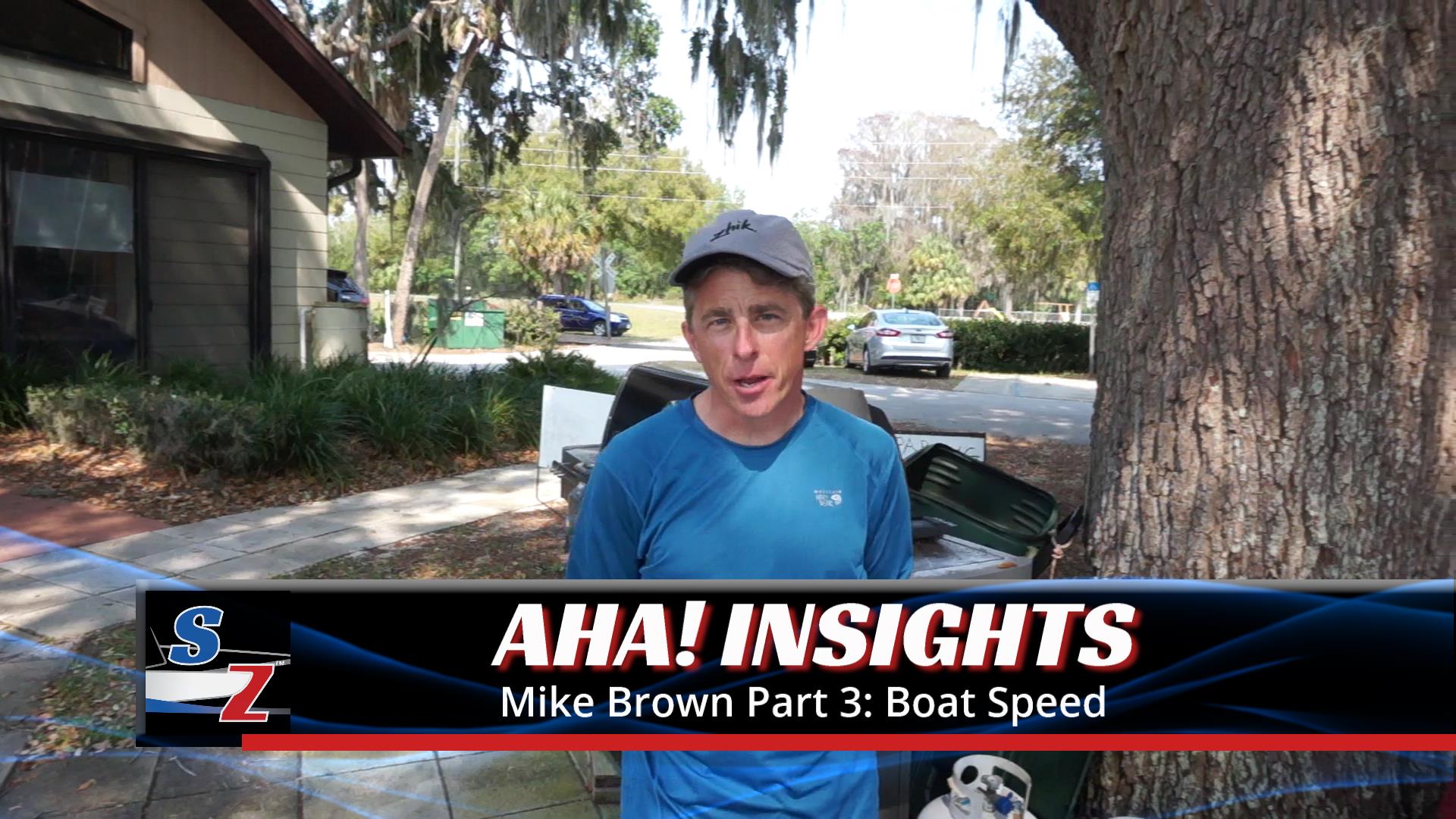[Lull response]: I fought my instinct to bear off, and instead, allowed the jib tales to stall while the boat decelerated over the next few boat lengths. We did ease both the main and jib sheets just a little to keep both leeches from hooking in with the decreased pressure. I waited until I felt we were down speed before I readjusted my steering angle to match the new lighter wind. It worked! We were now able to keep our height as we transitioned into the lull with little loss in forward [progress].
Mike Ingham in Sailing World
Lulls are inevitable. The instinctive response is to ease your sail and bear off to maintain boat speed and react to what you’re seeing in your sail telltales. However, this instinctive response is wrong. In this post, we summarize the expert advice for sailing lulls.
This post is a consolidation of two previous posts on sailing lulls, with new insights and a diagram added.
Background
Apparent wind response in a lull

First let’s remember what happens to the apparent wind when you sail into a lull. Apparent wind is the combination of the true wind and the “boat wind” – the headwind wind created as your boat moves forward. In a lull, the true wind decreases quickly, but the boat wind does not decrease until the boat slows down.
Thus, the apparent wind decreases and initially moves forward when the lull appears. As your boat coasts ahead and slows, the boat wind gradually decreases and the apparent wind moves back to roughly its original direction.
In short, when you sail into a lull, you get an apparent wind header, sometimes called a velocity header. Your luff telltales may flutter and you feel you are pinching. However, this header is short-lived: the header largely goes away as the boat slows down.
VMG in a lull
Let’s look the boat’s velocity made good (VMG) during a lull. The key concept is that as the wind velocity changes, you want to get to the new target boat speed quickly to maximize VMG. In a lull, your target boat speed decreases. So, perhaps counterintuitively, your goal is to bleed excess speed to get to the new target. For background on VMG, see our post Velocity Made Good (VMG) – Definition and Application, especially the section on target boat speeds.
Sailing Lulls Classic Technique
Now let’s explain the basis for classic lull response: pinch through the lulls, ease your sails slightly, and get your weight in quickly to maintain constant heel angle. Let’s talk about each of these.
Pinch Through the Lulls
When the lull hits, hold your course. If you are patient, the boat will slow down due to the lull, moving the apparent wind back closer to its direction before the lull. If the lull persists, your final heading might be only a touch lower than your original heading.
Resist the temptation to bear off initially.
- If you bear off when the lull first hits, you will then need to steer up again as the apparent wind comes back to its original direction. You’d be chasing the apparent wind. As an extreme example, think about your response if the true wind velocity went to zero. Would it make sense to bear off? Obviously not, because you would chase the apparent wind in a circle.
- When you bear off, you are losing distance to windward. If you don’t bear off, you can use your boat speed to coast forward on your original heading and gain distance to windward.
- Bearing off may keep your boat speed up, but your goal is to maximize VMG by getting to the new, lower target speed quickly. Pinching gets you there sooner.
- Following the lull, you can often expect new wind from the same direction. If you hold your heading, you are “pinching up” to this new expected wind.
Maintain Heel Angle
Maintaining the proper angle of heel is key. Be quick to shift your weight before the boat flattens.
Power up
Anticipate the lulls and adjust controls (vang, cunningham) in anticipation of the changing pressure. Power up in lulls with vang and cunningham eased or off. Ease the mainsheet a touch to keep the leech open. Powering up also gives you more time to get your weight in.
Examples
We found some good videos from the International Sailing Academy (ISA), showing the incorrect and “correct” response to a lull. These are also discussed in an ISA article on gust and lull management.
ISA Video: Lull Response – Incorrect
ISA Video: Lull Response – Correct
Mike Ingham video discussion of pinching through the lulls
Bethwaite’s Variation – First, Trim In and Feather Down
Frank Bethwaite adds a variation to these steps to get the most out of the initial response. In his book Fast Handling Technique, he argues that the lull response should be exactly the opposite of the gust response.
- Gust response: ease and feather up, hike, and then trim to new wind strength and head up if needed.
- Lull response: trim in and feather down, move weight in, and then ease to new wind strength and bear off if needed.
This sounds contrary to the classic response, but it’s not. Bethwaite still believes in pinching through the lull. His steps to trim in and feather down are a momentary response to help you pinch more successfully while the boat coasts. Let’s look at his reasoning:
- You can get a little more power from the sail as the apparent wind moves forward by trimming in. This more closely matches the sheeting angle to the new apparent wind. If you get a bit more power, even for a short time, this helps prevent the boat from rolling to windward while you move your weight in.
- If you feather slightly down – no more than 2-4 degrees – you are getting closer to the new apparent wind angle with minimal steering. Feathering won’t increase rudder drag significantly. If the lull persists, you will likely not need to steer down any further when things settle down.





